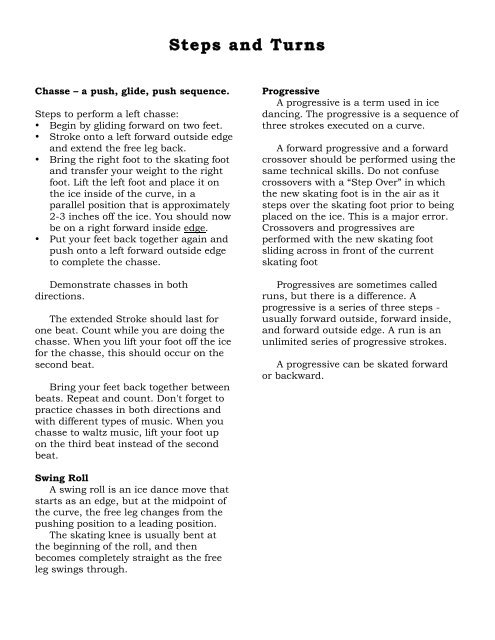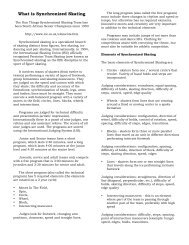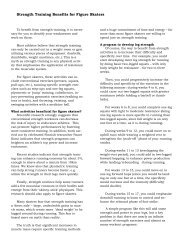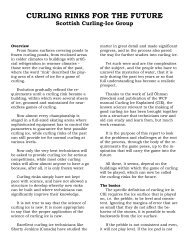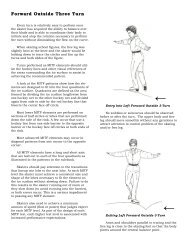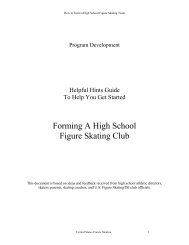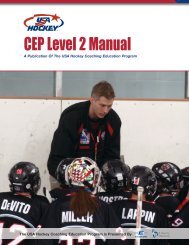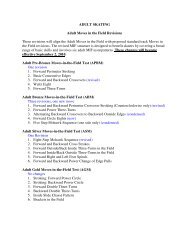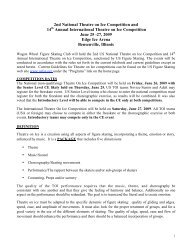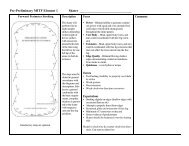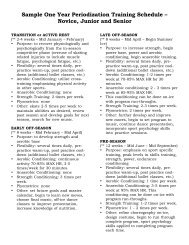Steps and Turns - Ice skating resources
Steps and Turns - Ice skating resources
Steps and Turns - Ice skating resources
Create successful ePaper yourself
Turn your PDF publications into a flip-book with our unique Google optimized e-Paper software.
<strong>Steps</strong> <strong>and</strong> <strong>Turns</strong><br />
Chasse – a push, glide, push sequence.<br />
<strong>Steps</strong> to perform a left chasse:<br />
• Begin by gliding forward on two feet.<br />
• Stroke onto a left forward outside edge<br />
<strong>and</strong> extend the free leg back.<br />
• Bring the right foot to the <strong>skating</strong> foot<br />
<strong>and</strong> transfer your weight to the right<br />
foot. Lift the left foot <strong>and</strong> place it on<br />
the ice inside of the curve, in a<br />
parallel position that is approximately<br />
2-3 inches off the ice. You should now<br />
be on a right forward inside edge.<br />
• Put your feet back together again <strong>and</strong><br />
push onto a left forward outside edge<br />
to complete the chasse.<br />
Demonstrate chasses in both<br />
directions.<br />
The extended Stroke should last for<br />
one beat. Count while you are doing the<br />
chasse. When you lift your foot off the ice<br />
for the chasse, this should occur on the<br />
second beat.<br />
Bring your feet back together between<br />
beats. Repeat <strong>and</strong> count. Don't forget to<br />
practice chasses in both directions <strong>and</strong><br />
with different types of music. When you<br />
chasse to waltz music, lift your foot up<br />
on the third beat instead of the second<br />
beat.<br />
Progressive<br />
A progressive is a term used in ice<br />
dancing. The progressive is a sequence of<br />
three strokes executed on a curve.<br />
A forward progressive <strong>and</strong> a forward<br />
crossover should be performed using the<br />
same technical skills. Do not confuse<br />
crossovers with a “Step Over” in which<br />
the new <strong>skating</strong> foot is in the air as it<br />
steps over the <strong>skating</strong> foot prior to being<br />
placed on the ice. This is a major error.<br />
Crossovers <strong>and</strong> progressives are<br />
performed with the new <strong>skating</strong> foot<br />
sliding across in front of the current<br />
<strong>skating</strong> foot<br />
Progressives are sometimes called<br />
runs, but there is a difference. A<br />
progressive is a series of three steps -<br />
usually forward outside, forward inside,<br />
<strong>and</strong> forward outside edge. A run is an<br />
unlimited series of progressive strokes.<br />
A progressive can be skated forward<br />
or backward.<br />
Swing Roll<br />
A swing roll is an ice dance move that<br />
starts as an edge, but at the midpoint of<br />
the curve, the free leg changes from the<br />
pushing position to a leading position.<br />
The <strong>skating</strong> knee is usually bent at<br />
the beginning of the roll, <strong>and</strong> then<br />
becomes completely straight as the free<br />
leg swings through.
One Foot Figure Skating <strong>Turns</strong><br />
Brackets<br />
A bracket turn is similar to a three turn,<br />
but a bracket turn is counter-rotated.<br />
The tracing the ice skate blade makes on<br />
the ice after the turn is completed points<br />
outward, <strong>and</strong> does not make a "3"<br />
pattern like the three turn. The turn can<br />
be performed from either an outside edge<br />
to an inside edge, or an inside edge to an<br />
outside edge.<br />
Types of Figure Skating <strong>Turns</strong><br />
Diagram by Dr. Arthur Schneider<br />
There are turns are classified as two<br />
different types of turns:<br />
• Performed on one foot<br />
o 3-Turn<br />
o Bracket<br />
o Counter<br />
o Rocker<br />
Counters<br />
In a counter the skater enters <strong>and</strong> exits<br />
on the same edge. A counter begins like a<br />
bracket, where the rotation of the body is<br />
counter to the natural direction of the<br />
curve made by the edge. Like the<br />
bracket, the top of the turn points out.<br />
The difference is that unlike the bracket<br />
turn, the edges before <strong>and</strong> after the turn<br />
makes opposite curves.<br />
• <strong>Turns</strong> requiring a change of feet<br />
o Mohawk<br />
o Choctaw<br />
3-<strong>Turns</strong><br />
The easiest one-foot turn is the 3-Turn.<br />
In a three turn, the ice skate blade<br />
makes the pattern of a "3" on the ice.<br />
Three turns are done from either an<br />
outside edge to an inside edge, or an<br />
inside edge to an outside edge. The<br />
direction of the turn follows the way the<br />
edge rotates <strong>and</strong> curves.<br />
Rockers<br />
Rockers are the opposite of counters. A<br />
rocker turn starts like a three turn, but<br />
unlike a three turn, the turn occurs from<br />
same edge to same edge. Also, like a
counter turn, the turn continues on a<br />
different curve.<br />
Mohawk<br />
Definition: A Mohawk is an ice <strong>skating</strong><br />
turn that is done from same edge to<br />
same edge, from either forward to<br />
backward or backward to forward.<br />
Examples:<br />
Most figure skaters enter a waltz jump<br />
from a back outside Mohawk. A back<br />
outside Mohawk is usually easier for new<br />
ice skaters than a forward inside<br />
Mohawk.<br />
Choctaw<br />
A Choctaw is a figure <strong>skating</strong> turn. The<br />
turn is made from one edge to another<br />
edge, from forward to backward or<br />
backward to forward. The Choctaw turn<br />
has some similarities to a Mohawk turn.<br />
What makes the turns similar is that the<br />
skater turns from either forward to<br />
backward or backward to forward <strong>and</strong><br />
changes feet in the process.<br />
Mohawk turns are made from same edge<br />
to same edge. A Choctaw turn requires<br />
the skater to go from one edge to a<br />
different edge. Choctaws can be entered<br />
on an inside edge <strong>and</strong> exited on an<br />
outside edge or be entered on an outside<br />
edge <strong>and</strong> be exited on an inside edge.<br />
Examples: Choctaw turns are done in<br />
some compulsory ice dances. Some<br />
dances that include a Choctaw turn are<br />
the Blues, Killian, Quickstep, <strong>and</strong><br />
Rhumba.<br />
Free skaters don't always realize that<br />
they are doing a Choctaw turn when they<br />
enter spins from a back inside edge to a<br />
forward outside edge.<br />
<strong>Turns</strong> on one foot were exclusively<br />
used in compulsory figures<br />
Figure <strong>skating</strong> is called "figure <strong>skating</strong>"<br />
because of the sport's original emphasis<br />
on compulsory figures. The figures were<br />
designed to be performed on a clean<br />
sheet of ice.<br />
All of the one foot turns done in figure<br />
<strong>skating</strong> were originally included in the<br />
st<strong>and</strong>ard U.S. Figure Skating figure tests.<br />
3-<strong>Turns</strong> were introduced very early in the<br />
test structure. As skaters advanced, they<br />
were required to perform brackets,<br />
counters <strong>and</strong> rockers.


